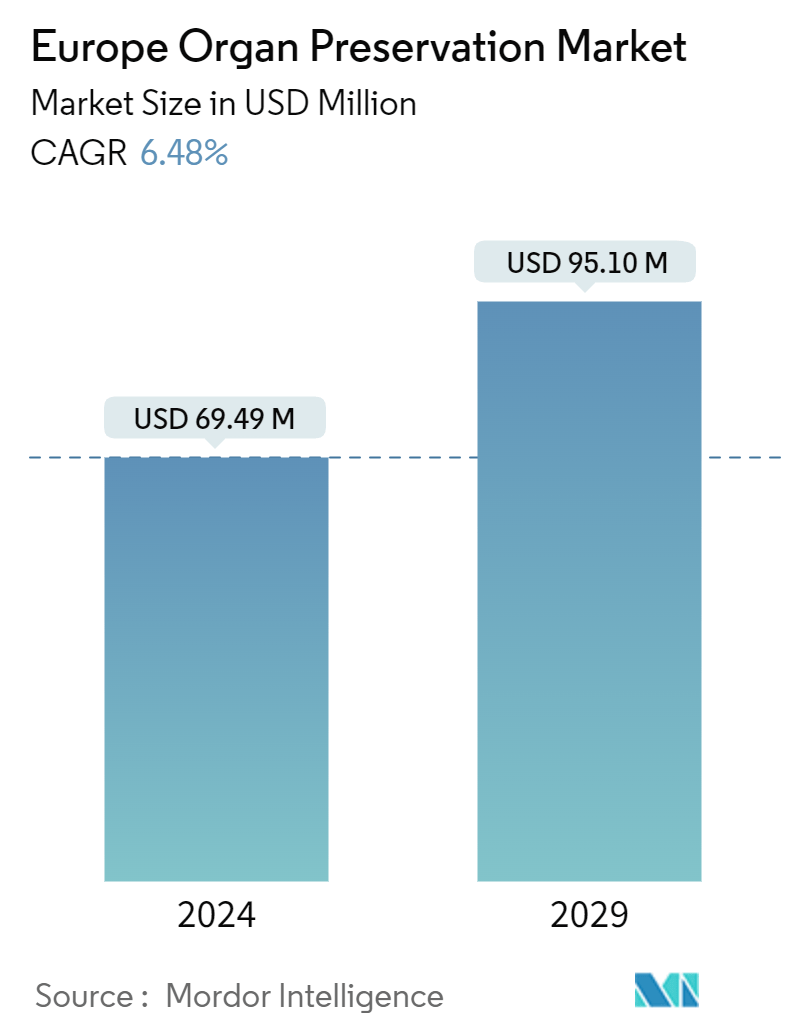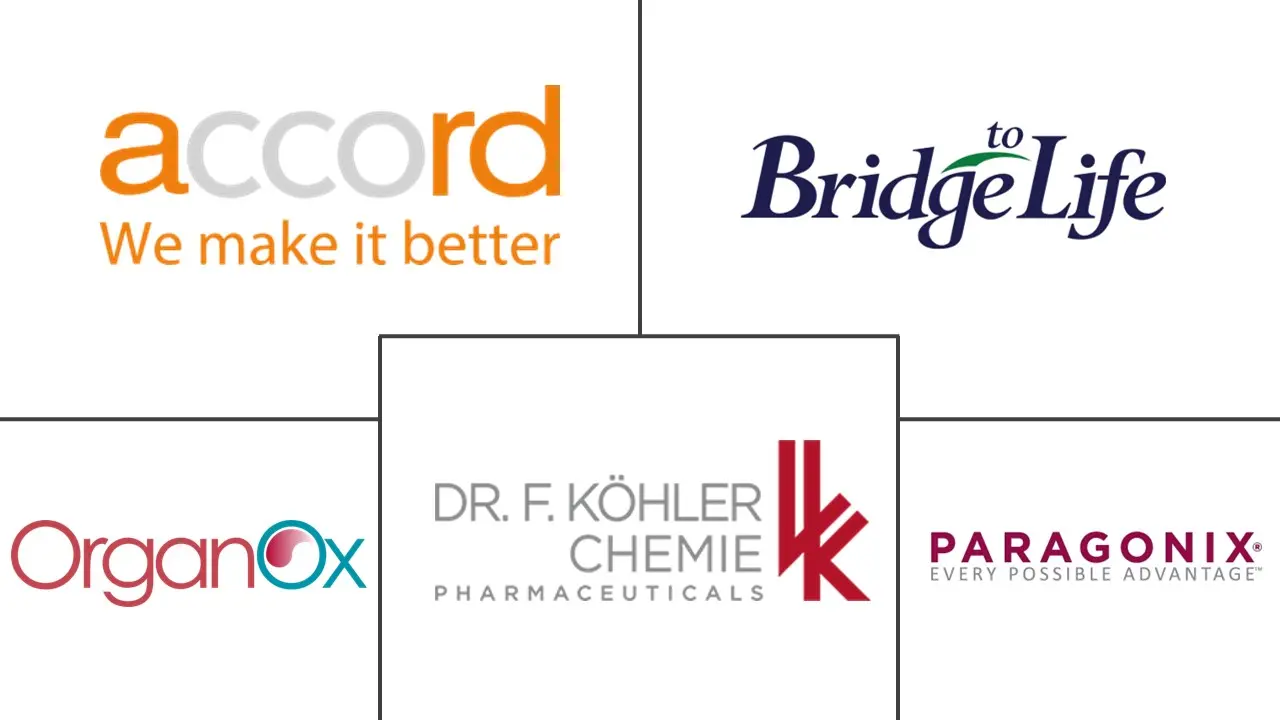Market Size of Europe Organ Preservation Industry

| Study Period | 2019 - 2029 |
| Base Year For Estimation | 2023 |
| Market Size (2024) | USD 69.49 Million |
| Market Size (2029) | USD 95.10 Million |
| CAGR (2024 - 2029) | 6.48 % |
| Market Concentration | Medium |
Major Players
*Disclaimer: Major Players sorted in no particular order |
Europe Organ Preservation Market Analysis
The Europe Organ Preservation Market size is estimated at USD 69.49 million in 2024, and is expected to reach USD 95.10 million by 2029, growing at a CAGR of 6.48% during the forecast period (2024-2029).
Factors such as rising cases of multiple organ failure in the aging population, technological advancements, and increasing government and non-profit organization initiatives to encourage organ donation are expected to drive the market’s growth during the forecast period. For instance, according to the Council of Europe report in October 2022, thousands of patients were on waiting lists due to a chronic shortage of organs, tissues, and cells.
An increase in organ donation cases in Europe is expected to drive the market’s growth during the forecast period. For instance, as per the International Registry in Organ Donation and Transplantation 2024 report, the living organ donor rate for New Zealand was 1,500 per million population in 2023. In Switzerland, the rate was 1,250 per million people in 2023. Hence, the high rate of organ donation cases in European countries is expected to drive market growth during the forecast period.
Furthermore, strategic activities and funding related to organ preservation are expected to fuel the market growth over the forecast period. For instance, in September 2022, CE marking was obtained for its additive to organ preservation solutions HEMO2life. HEMO2life revolutionizes the preservation of grafts awaiting transplantation without modifying clinical protocols and with a demonstrated effect on the survival of post-transplant patients. Hence, owing to such advancements in organ presentation solutions, further market approvals are expected to drive market growth during the forecast period.
Various initiatives taken by key players, such as product launches, investments, and partnerships to increase the footprint, are expected to boost the market's growth during the forecast period. For instance, in July 2023, UK-based OrganOx secured GBP 25 million (USD 2.6 billion) in growth funding, with support from existing investors to prolong liver preservation 24 hours before a transplant. Thus, such funding activities are expected to drive the market’s growth during the forecast period.
Thus, funding activities, regulatory approvals for organ preservation solutions, and a number of organ transplant cases are expected to drive the market's growth during the forecast period. However, the high cost of organ transplantation and limited medical reimbursements for organ donation and transplantation are expected to restrain the market's growth.
Europe Organ Preservation Industry Segmentation
As per the scope of the report, organ preservation is the supply line for organ transplantation. Presently, the liver, pancreas, and kidney are major organs that can be successfully preserved for up to two days by flushing the organs.
The European organ preservation market is segmented by technique, product type, organ type, and geography. By technique, the market is segmented into static cold storage (SCS) technique, hypothermic machine perfusion, and normothermic machine perfusion. By product type, the market is segmented into preservation solutions, transport systems, and other product types. By organ type, the market is segmented into kidneys, liver, lung, heart, and other organ types. By geography, the market is segmented into Germany, the United Kingdom, France, Italy, Spain, and the Rest of Europe. The report offers the value (USD) for the above segments.
| By Technique | |
| Static Cold Storage (SCS) Technique | |
| Hypothermic Machine Perfusion | |
| Normothermic Machine Perfusion |
| By Product Type | |
| Preservation Solutions | |
| Transport Systems | |
| Other Product Types |
| By Organ Type | |
| Kidneys | |
| Liver | |
| Lung | |
| Heart | |
| Other Organ Types |
| By Geography | |
| Germany | |
| United Kingdom | |
| France | |
| Italy | |
| Spain | |
| Rest of Europe |
Europe Organ Preservation Market Size Summary
The European organ preservation market is poised for significant growth, driven by factors such as the increasing incidence of multiple organ failures in the aging population, technological advancements, and heightened efforts by government and non-profit organizations to promote organ donation. The market is expected to expand as a result of strategic activities and funding aimed at enhancing organ preservation techniques. Innovations like the CE-marked HEMO2life solution, which improves graft preservation without altering clinical protocols, exemplify the advancements propelling the market forward. Additionally, substantial funding activities, such as OrganOx's recent financial boost, are set to enhance liver preservation techniques, further contributing to market growth. However, challenges such as the high costs of organ transplantation and limited medical reimbursements may pose constraints to the market's expansion.
The demand for kidney preservation is particularly driving segmental growth, as kidney transplantation remains a critical treatment for end-stage kidney disease. The need for efficient preservation techniques is underscored by the rising demand for transplants and the complexities associated with high-risk organs. Government support programs and technological innovations, such as the oxygen-based preservation method developed in Belgium, are expected to bolster the market. The United Kingdom is anticipated to experience notable market growth due to the increasing number of patients requiring transplants and the presence of advanced preservation technologies. The market is characterized by a semi-consolidated landscape with key players like Intas Pharmaceuticals, Bridge to Life Ltd, and OrganOx Limited actively engaging in strategies to expand their market presence.
Europe Organ Preservation Market Size - Table of Contents
-
1. MARKET DYNAMICS
-
1.1 Market Overview
-
1.2 Market Drivers
-
1.2.1 Rising Cases of Multiple Organ Failure in Ageing Population
-
1.2.2 Technological Advancements
-
1.2.3 Increasing Government and Non-profit Organization Initiatives to Encourage Organ Donation
-
-
1.3 Market Restraints
-
1.3.1 High Cost of Organ Transplantation
-
1.3.2 Limited Medical Reimbursements for Organ Donation and Transplantation
-
-
1.4 Porter's Five Forces Analysis
-
1.4.1 Threat of New Entrants
-
1.4.2 Bargaining Power of Buyers/Consumers
-
1.4.3 Bargaining Power of Suppliers
-
1.4.4 Threat of Substitute Products
-
1.4.5 Intensity of Competitive Rivalry
-
-
-
2. MARKET SEGMENTATION (Market Size by Value - USD)
-
2.1 By Technique
-
2.1.1 Static Cold Storage (SCS) Technique
-
2.1.2 Hypothermic Machine Perfusion
-
2.1.3 Normothermic Machine Perfusion
-
-
2.2 By Product Type
-
2.2.1 Preservation Solutions
-
2.2.2 Transport Systems
-
2.2.3 Other Product Types
-
-
2.3 By Organ Type
-
2.3.1 Kidneys
-
2.3.2 Liver
-
2.3.3 Lung
-
2.3.4 Heart
-
2.3.5 Other Organ Types
-
-
2.4 By Geography
-
2.4.1 Germany
-
2.4.2 United Kingdom
-
2.4.3 France
-
2.4.4 Italy
-
2.4.5 Spain
-
2.4.6 Rest of Europe
-
-
Europe Organ Preservation Market Size FAQs
How big is the Europe Organ Preservation Market?
The Europe Organ Preservation Market size is expected to reach USD 69.49 million in 2024 and grow at a CAGR of 6.48% to reach USD 95.10 million by 2029.
What is the current Europe Organ Preservation Market size?
In 2024, the Europe Organ Preservation Market size is expected to reach USD 69.49 million.

